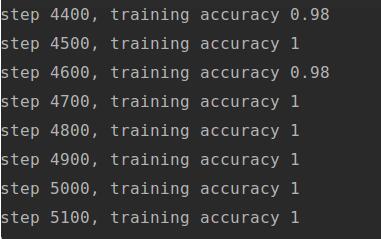本文使用的数据集是MNIST,主要使用两个卷积层加一个全连接层构建的卷积神经网络。
先载入MNIST数据集(手写数字识别集),并创建默认的Interactive Session(在没有指定回话对象的情况下运行变量)
|
1
2
3
4
|
from tensorflow.examples.tutorials.mnist import input_data import tensorflow as tf mnist = input_data.read_data_sets("MNIST_data/", one_hot=True) sess = tf.InteractiveSession() |
在定义一个初始化函数,因为卷积神经网络有很多权重和偏置需要创建。
|
1
2
3
4
5
6
7
8
|
def weight_variable(shape): initial = tf.truncated_normal(shape, stddev=0.1)#给权重制造一些随机的噪声来打破完全对称, return tf.Variable(initial) #使用relu,给偏置增加一些小正值0.1,用来避免死亡节点 def bias_variable(shape): initial = tf.constant(0.1, shape=shape) return tf.Variable(initial) |
卷积移动步长都是1代表会不遗漏的划过图片的每一个点,padding代表边界处理方式,same表示给边界加上padding让卷积的输出和输入保持同样的尺寸。
|
1
2
3
4
5
6
|
def conv2d(x,W):#2维卷积函数,x输入,w是卷积的参数,strides代表卷积模板移动步长 return tf.nn.conv2d(x, W, strides=[1, 1, 1, 1], padding='SAME') def max_pool_2x2(x): return tf.nn.max_pool(x, ksize=[1, 2, 2, 1], strides=[1, 2, 2, 1], padding='SAME') |
在正式设计卷积神经网络结构前,先定义输入的placeholder(类似于c++的cin,要求用户运行时输入)。因为卷积神经网络会利用到空间结构信息,因此需要将一维的输入向量转换为二维的图片结构。同时因为只有一个颜色通道,所以最后尺寸为【-1, 28,28, 1],-1代表样本数量不固定,1代表颜色通道的数量。
这里的tf.reshape是tensor变形函数。
|
1
2
3
|
x = tf.placeholder(tf.float32, [None, 784])# x 时特征 y_ = tf.placeholder(tf.float32, [None, 10])# y_时真实的label x_image = tf.reshape(x, [-1, 28, 28,1]) |
接下来定义第一个卷积层。
|
1
2
3
4
5
|
w_conv1 = weight_variable([5, 5, 1, 32])#代表卷积核尺寸为5X5,1个颜色通道,32个不同的卷积核,使用conv2d函数进行卷积操作, b_conv1 = bias_variable([32]) h_conv1 = tf.nn.relu(conv2d(x_image, w_conv1) + b_conv1) h_pool1 = max_pool_2x2(h_conv1) |
定义第二个卷积层,与第一个卷积层一样,只不过卷积核的数量变成了64,即这层卷积会提取64种特征
|
1
2
3
4
|
w_conv2 = weight_variable([5, 5, 32, 64])#这层提取64种特征 b_conv2 = bias_variable([64]) h_conv2 = tf.nn.relu(conv2d(h_pool1, w_conv2) + b_conv2) h_pool2 = max_pool_2x2(h_conv2) |
经过两次步长为2x2的最大池化,此时图片尺寸变成了7x7,在使用tf.reshape函数,对第二个卷积层的输出tensor进行变形,将其从二维转为一维向量,在连接一个全连接层(隐含节点为1024),使用relu激活函数。
|
1
2
3
4
|
w_fc1 = weight_variable([7*7*64, 1024]) b_fc1 = bias_variable([1024]) h_pool2_flat = tf.reshape(h_pool2, [-1, 7*7*64]) h_fc1 = tf.nn.relu(tf.matmul(h_pool2_flat, w_fc1) + b_fc1) |
Dropout层:随机丢弃一部分节点的数据来减轻过拟合。这里是通过一个placeholder传入keep_prob比率来控制的。
|
1
2
3
4
5
6
7
8
|
#为了减轻过拟合,使用一个Dropout层 keep_prob = tf.placeholder(tf.float32) h_fc1_drop = tf.nn.dropout(h_fc1, keep_prob) #dropout层的输出连接一个softmax层,得到最后的概率输出 w_fc2 = weight_variable([1024, 10]) b_fc2 = bias_variable([10]) y_conv = tf.nn.softmax(tf.matmul(h_fc1_drop, w_fc2) + b_fc2) |
定义损失函数即评测准确率操作
|
1
2
3
4
5
6
7
|
#损失函数,并且定义优化器为Adam cross_entropy = tf.reduce_mean(-tf.reduce_sum(y_ * tf.log(y_conv), reduction_indices=[1])) train_step = tf.train.AdamOptimizer(1e-4).minimize(cross_entropy) correct_prediction = tf.equal(tf.argmax(y_conv, 1), tf.argmax(y_, 1)) accuracy = tf.reduce_mean(tf.cast(correct_prediction, tf.float32)) |
开始训练
|
1
2
3
4
5
6
7
8
9
|
#初始化所有参数 tf.global_variables_initializer().run() for i in range (20000): batch = mnist.train.next_batch(50) if i%100 == 0: train_accuracy = accuracy.eval(feed_dict={x:batch[0], y_: batch[1], keep_prob: 1.0}) print("step %d, training accuracy %g"%(i, train_accuracy)) train_step.run(feed_dict={x: batch[0], y_: batch[1], keep_prob: 0.5}) |
全部训练完成后,我们在最终的测试集上进行全面的测试,得到整体的分类准确率。
|
1
2
|
print("test accuracy %g" %accuracy.eval(feed_dict={ x: mnist.test.images, y_: mnist.test.labels, keep_prob: 1.0})) |
这个网络,参与训练的样本数量总共为100万,共进行20000次训练迭代,使用大小为50的mini_batch。

因为我安装的版本时CPU版的tensorflow,所以运行较慢,这个模型最终的准确性约为99.2%,基本可以满足对手写数字识别准确率的要求。
以上就是本文的全部内容,希望对大家的学习有所帮助,也希望大家多多支持服务器之家。
原文链接:https://blog.csdn.net/weixin_40533355/article/details/80418378










